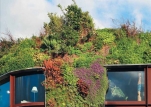Bio-Concrete: Tableaux on the Facades

The future of design requires thinking innovatively about the way of current construction techniques function so we may expand upon their capabilities. Sustainability has evolved far beyond being a trend and has become an indelible part of this design process. Sustainable solutions have always pushed against the status quo of design and now the Structural Technology Group of Universitat Politècnica de Catalunya – BarcelonaTech (UPC ) has developed a concrete that sustains and encourages the growth of a multitude of biological organisms on its surface.
We have seen renditions of the vertical garden and vegetated facades, but what sets the biological concrete apart from these other systems is that it is an integral part of the structure. According to an article in Science Daily, the system is composed of three layers on top of the structural elements that together provide ecological, thermal and aesthetic advantages for the building.
The Structural Technology Group has developed and patented a type of biological concrete that supports the natural, accelerated growth of pigmented organisms. The material, which has been designed for the façades of buildings or other constructions in Mediterranean climates, offers environmental, thermal and aesthetic advantages over other similar construction solutions. The material improves thermal comfort in buildings and helps to reduce atmospheric CO2 levels.
In studying this concrete, the researchers at the Structural Technology Group of the Universitat Politècnica de Catalunya – BarcelonaTech (UPC) have focused on two cement-based materials. The first of these is conventional carbonated concrete (based on Portland cement), with which they can obtain a material with a pH of around 8. The second material is manufactured with the magnesium phosphate cement (MPC), a hydraulic conglomerate that does not require any treatment to reduce its pH, since it is slightly acidic.
On account of its quick setting properties, magnesium phosphate cement has been used in the past as a repair material. It has also been employed as bio-cement in the field of medicine and dentistry, indicating that it does not have an additional environmental impact.
The innovative feature of this new (vertical multilayer) concrete is that it acts as a natural biological support for the growth and development of certain biological organisms, to be specific, certain families of microalgae, fungi, lichens and mosses.
Having patented the idea, the team is investigating the best way to promote the accelerated growth of these types of organisms on the concrete. The goal of the research is to succeed in accelerating the natural colonization process so that the surface acquires an attractive appearance in less than a year. A further aim is that the appearance of the façades constructed with the new material should evolve over time, showing changes of colour according to the time of year and the predominant families of organisms. On these kinds of buildings, other types of vegetation are prevented from appearing, lest their roots damage construction elements.
Full content of this issue you can read here
The full version of the article can be read in our printed issue, also you can subscribe to the web-version of the magazine
 This article is based on submissions of the Polytechnic University of Catalonia (Universitat Politècnica de Catalunya, UPC)
This article is based on submissions of the Polytechnic University of Catalonia (Universitat Politècnica de Catalunya, UPC)


